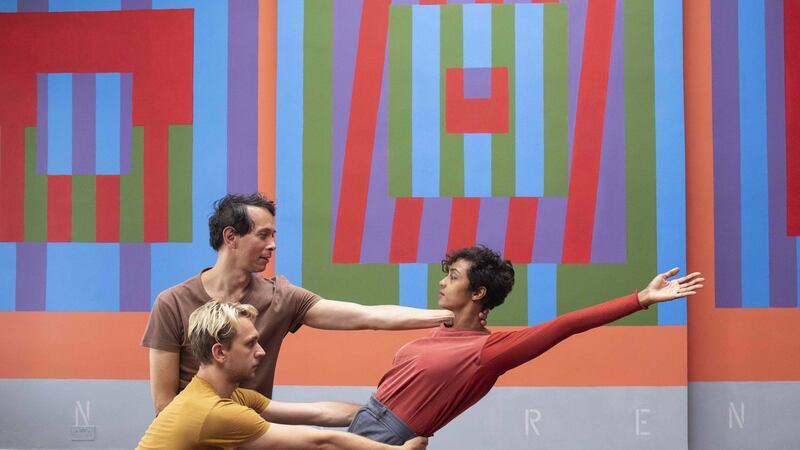Personal identity was a common theme in two dance performances at Cork Midsummer, but the venue for each played as strong a role as the individual performers. Both venues also had a sense of impermanence that mirrored the ephemerality of the dance, one taking place in the soon-to-be-demolished Sunbeam Bingo Hall, the other inspired by Brian O'Doherty's floor-to-ceiling murals at Sirius Arts Centre, hidden for decades and now on display again for one year.
The industrial exterior of Sunbeam Bingo Hall, located on the outskirts of Cork city, hides a faded grandeur within. On entering, a wide staircase and green marble floor leads to a waiting area for audience members with couches, coffee tables and knick-knacks from the 1950s. Hugh Scannell and Luca Squillacciotti (both members of youth dance group FC/DC) appear and are carried into the bingo hall wearing "Follow me" signs. Processing through the doors the audience find a dark low-ceilinged expanse with rows of four-seated booths and tables in symmetrical lines.
Like in the waiting area, designer Sarah Jane Shiels adds to the sense of nostalgia with frilly lamp shades hanging throughout the space and old knitting magazines strewn on the tables.
Doppelgänger
The notion of a doppelgänger is at the centre of the dance, traditionally treated with either bemusement or fear. As a narrative it can be found in folklore – Narcissus falling in love with his reflection, Nordic vardøgers or Egyptian kas – as well as particle physics and supersymmetry theory, which posits that every particle has a doppelgänger.
The proximity to the performers created a totally immersive experience
In Man At The Door (Number 54), choreographers (and identical twins) Jessica Kennedy and Megan Kennedy present themselves and the other dancers as sets of doubles with simple mirroring actions that set up an intriguing ambiguity of whether each performer is a doppelgänger or simply a reflection of the one person. A duet by Lucia Kickham and Siobhán Ní Dhuinnín suggests the latter, as they grapple with each other, one trying to suppress the other like a struggle between the ego and the id. This confrontational rivalry spilled in to later duets as the action grew darker and a black clothed faceless shadow menacingly emerged from under one of the tables (in some accounts evil doppelgängers had no shadow).
With the action taking place between, on and under the tables, the proximity to the performers created a totally immersive experience and the surroundings were at once cocooning and claustrophobic.
After their previous two works, Dolores (concerning the abuse of Dolores Haze in Nabokov's Lolita) and Soldier Still (dealing with institutionalised violence), this work sees Junk Ensemble return to themes of inbetweenness and the ambiguity between dark and light. At the end of the work there is time for one last game of bingo as the hall is fittingly given the last word.

Junk Ensemble's windowless setting was in contrast to the bright and joyous sun-filled rooms in Cobh's Sirius Arts Centre for Liz Roche Dance Company's Pilgrimage, one of a number of artistic responses to Brian O'Doherty's One, Here, Now. A series of floor-to-ceiling murals created 20 years ago, they were subsequently covered in lining paper and white paint, but have now been restored by Don Knox and will be on display for a year. Based on Ogham (the lines spelling One Here Now), the paintings are bold and geometric with bright blue, green, red and purple stripes and feel both modern and ancient.
Identity and sense of place is a constant through the exhibition and performances
Just as O'Doherty played with permanence and impermanence in both title and paintings, choreographer Liz Roche and co-collaborator composer Linda Buckley have created an impressive work that celebrates the immediacy of the present, but leaves etchings of ghostly afterimages and sounds. Just as the paintings will maintain a hidden presence after they are (more carefully) covered up again next April, so too will the sounds and images add to a collective artistic memory.
Identity and sense of place is a constant through the exhibition and performances. One trio, performed outside by dancers Sarah Cernaux, Kévin Coquelard and Henry Montes, is particularly poignant and beautifully sustained with lifts and supporting gestures. Unfortunately, Ilse de Ziah's solo cello accompaniment was the weakest music of the work, in contrast to more glorious playing and singing by Robbie Blake, Suzanne Savage and Vivienne Hassell elsewhere in the generously resonant rooms.
One of the most striking images was of the three dancers facing the sea with arms exuberantly outstretched, slowly tensing and falling until they were shaking their gnarled hands in front of them. It seemed to sum up the hope-to-despair experience of many immigrants that left from Cobh. A final climactic dance trio surrounded by the murals was powerfully sustained by Buckley's music with movement sequences and gestures that disappeared and reappeared until a final breathless collapse.









